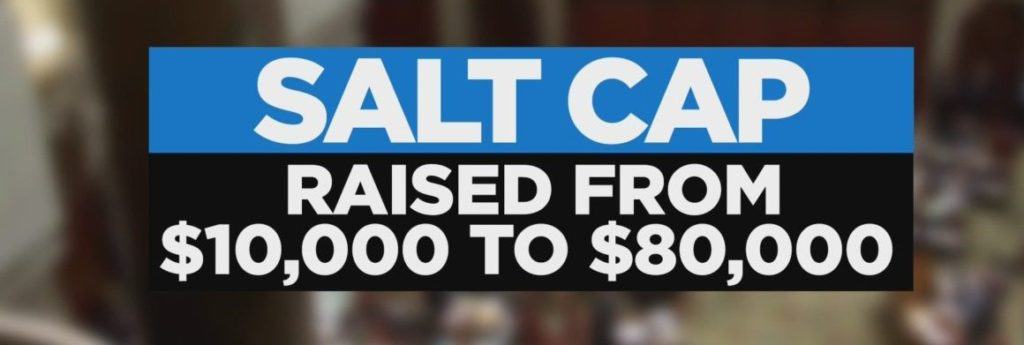
In 2017 President Donald Trump and then House Speaker Paul Ryan eliminated unlimited deductions that residents in high property and income tax states like New York and California can take on their Federal taxes, capping the State and Local Tax deduction at $10,000. This deduction, also known as SALT, was passed, in part, because Ryan and the House Republicans no longer wanted to subsidize what they viewed as the overspending and overtaxation by high tax states like NY and California, and then President Trump did nothing to stop them.
The SALT tax deduction cap of $10,000 really hit home in Westchester, whose homeowners pay the highest property taxes in the nation. For example, a homeowner in Scarsdale who pays $60,000 per year in property taxes, (based on a $3 Million home value) and who pays $20,000 in NY State income taxes, (based on $400,000 per year in income), could only deduct $10,000 out of $80,000 in state and local taxes, losing out on a $70,000 tax deduction on their federal income taxes every year.
But another argument has now taken hold in the progressive wing of the democratic party. That family that makes $400,000 per year and lives in a $3 Million home in Scarsdale-do they deserve tax relief from the SALT tax deduction cap?
President Joe Biden, and US Senator Bernie Sanders, Chairman of the Senate Budget Committee (yes folks Bernie is the Chair of the Budget Committee) both want to give any tax relief to families earning less than $400,000 per year. So Sanders, and NJ Senator Robert Menendez (from another high SALT tax state) have proposed providing families with incomes of less than $400,000 with a SALT tax break. They will not be subject to the SALT tax cap deduction, and will be able to deduct all of their property taxes and state income taxes.
But what Sanders wants to do in the Senate is not what was passed in the House of Representatives under the Build Back Better bill that we recently passed. Under the House plan, the SALT cap would be raised from $10,000 to $80,000 through 2030.
So that same homeowner in Scarsdale that has $80,000 in property and state income taxes would get their SALT deduction back. Westchester County Executive George Latimer supports the SALT changes that passed the House. “The largest tax increase felt by Westchester County taxpayers was the – intentionally targeted – capping of the State & Local Tax Deduction at $10K included in the Trump/GOP tax plan passed in 2017. In a move that will lift up Westchester’s hard-working middle class homeowners, the House of Representatives raised this cap as a part of the Build Back Better social infrastructure package.
“Westchester’s middle-class homeowners chose to live here because of the exceptional services provided by local governments, schools and municipal entities. Mass transit, educational opportunities, public safety officers and investments like our award-winning parks system all add to the high quality of life in our region. Thank you to Westchester Representatives Sean Patrick Maloney, Mondaire Jones & Jamaal Bowman for their efforts to keep this provision in the BBB and thanks as well to Majority Leader Chuck Schumer and Senator Kirsten Gillibrand for continuing their fight in the Senate on behalf of our community,” said Latimer.
Long Island Homeowners, Putnam, Rockland and Dutchess County homeowners, and homeowners in Connecticut, were also affected by the SALT changes four years ago.
A “middle class” homeowner in Westchester who pays $15,000 per year in property taxes and $5,000 in State income taxes would now be able to deduct an additional $10,000 in taxes on their federal return.
The alternative from Senators Sanders and Menendez would exempt people below a certain income threshold from the $10,000 cap. Sanders has suggested setting the threshold at $400,000, consistent with President Biden’s pledge not to raise taxes on households with incomes below that level; Senator Menendez would set the threshold somewhat higher. Either way, this approach would exempt the vast majority of households — including all middle-income households — from the cap. And it would avoid the biggest flaw in the House proposal, which would provide wholly unnecessary tax cuts of up to $25,900 to many of the country’s richest people, as explained below.
Here’s some background. The SALT cap in the 2017 tax law targeted households with higher incomes who pay substantial state and local taxes; these households disproportionately live in states that impose higher taxes to support more robust public services, where political power tends to be held by Democrats. In these states, the cap typically affects about 9 in 10 households with incomes in the top 95th to 99th percentiles. But these households still received the largest net tax cut from the 2017 tax law, measured as a share of their income, because the other tax cuts in the 2017 law far outweighed the tax increase imposed by the SALT cap — even in the states most affected by the cap.
There are several reasons why these households received such large tax cuts from the 2017 tax law despite the SALT cap, but two stand out. First, the law lowered income tax rates across many of the seven tax brackets, and all of these rate cuts benefit upper-income households. Second, the law substantially scaled back the AMT in ways that made the AMT much less likely to affect taxpayers in the 95th to 99th percentiles. In New Jersey, for example, where this group has incomes ranging from roughly $337,000 to $1.1 million, they received tax cuts averaging 3.5 percent of income from the 2017 law, according to the Institute on Taxation and Economic Policy. The top 1 percent of households also received large tax cuts from the 2017 law. None of these high-income households needs another tax cut.





